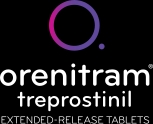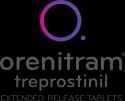Transcript
Good Days With Orenitram: Tips for starting treatment and staying on track
PAH is a progressive disease that causes the blood vessels in your lungs to become narrower, making it harder for blood to flow—which puts strain on the heart.
These changes are thought to be caused by an imbalance of certain chemicals in the body. There are different treatment options for each of these pathways.
But there are steps you and your healthcare team can take to help you reach your treatment goals—and help control your PAH with Orenitram.
Orenitram is a pill with the same proven medicine that's been available with a pump for over 2 decades.
And it works differently from other oral medications you may be taking for PAH.
Orenitram is proven to delay the progression of PAH and improve exercise capacity and may help improve PAH symptoms.
Many people showed improvement in as little as 3 months.
When you start Orenitram, your healthcare provider will gradually increase your dose until they find what's most effective for you—a process called titration.
During titration, you may experience side effects. This is expected as your body adjusts to the medicine.
The most common side effects of Orenitram include headache, diarrhea, nausea, vomiting, flushing, and pain in the arms, legs, and jaw.
Talk with your healthcare team about expected side effects, so they can suggest ways to manage them.
The fact is, side effects can be tough at first. But they can be managed—and may go down as the dose is increased over time.
Taking Orenitram with food helps the body absorb the medicine, which may also help reduce expected side effects.
Treatment needs may change over time. So your healthcare provider may continue to adjust your dose.
Patients on stable doses of treprostinil pump therapy transitioning to Orenitram may have different dosing needs. Talk to your healthcare team about what to expect.
Starting treatment can be a challenge. But getting better may be possible if you stick with it!
Keep in mind that every dose you take is important. To avoid missing one, try adding alerts to your calendar.
And remember, you don't have to do this alone. We offer support every step of the way including United Therapeutics Cares.
Visit Orenitram.com to explore more resources.
Let's do this together, one step at a time.
Because staying on track with Orenitram means you have a chance to see real improvement.
You got this.
And now we'd like to share with you some Important Safety Information for Orenitram.
IMPORTANT SAFETY INFORMATION FOR ORENITRAM
Who should not take Orenitram?
Do not take Orenitram if you have severe liver problems.
What should I tell my healthcare provider before taking Orenitram?
Tell your healthcare provider:
- If you have liver problems or diverticulosis.
- If you are pregnant, breastfeeding, and/or plan to become pregnant or breastfeed. It is not known if Orenitram will harm your unborn baby or if Orenitram passes into your breast milk. Talk to your healthcare provider about the best way to feed your baby during treatment with Orenitram.
- About all the medicines you take, including prescription and over-the-counter medicines, vitamins, and herbal supplements. Orenitram and other medicines may affect each other causing side effects. Do not start any new medicine until you check with your healthcare provider. Especially tell your healthcare provider if you take another medicine that contains treprostinil, such as Remodulin® or Tyvaso®.
How should I take Orenitram?
- Do not change your dose or suddenly stop taking Orenitram without first talking to your healthcare provider.
- Orenitram is usually taken 3 times a day (about every 8 hours) or 2 times a day (about every 12 hours). Your healthcare provider will tell you how often you should take Orenitram. If you have side effects, your healthcare provider may tell you to change your dose or when you take Orenitram. Take Orenitram with food.
- Swallow Orenitram tablets whole. Do not split, chew, crush, or break your Orenitram tablets. Do not take Orenitram tablets that are damaged or broken. If Orenitram tablets are not taken whole, they may release too much medicine at one time. This can lead to side effects.
- If you miss your dose of Orenitram, take the missed dose as soon as possible with food.
- If you miss 2 or more doses of Orenitram, call your healthcare provider to see if you need to change your dose.
- If you take too much Orenitram, call your healthcare provider or go to the nearest hospital emergency room right away.
- You may see the tablet shell in your stools (bowel movements). This is usually normal. The tablet shell is not digested. If you have diverticulosis, the tablet shell may get stuck in a blind pouch or diverticulum in your intestine.
What are the possible side effects of Orenitram?
Orenitram can cause serious side effects, including worsening of PAH symptoms.
- Stopping Orenitram suddenly may cause worsening of your PAH symptoms. Do not change your dose or suddenly stop taking Orenitram without first talking to your healthcare provider.
- The most common side effects of Orenitram include headache, diarrhea, nausea, vomiting, flushing, and pain in arms, legs, and jaw.
- These are not all of the possible side effects of Orenitram. Tell your healthcare provider if you have any side effect that bothers you or does not go away.
- Call your healthcare provider for medical advice about side effects. You may report side effects to the FDA at www.fda.gov/MedWatch or call 1‑800‑FDA‑1088.
What is Orenitram?
Orenitram is a prescription medicine used to treat pulmonary arterial hypertension (PAH) which is high blood pressure in the arteries of your lungs. Orenitram can help slow down the progression of your disease and improve your ability to exercise. It is not known if Orenitram is safe and effective in children.
The risk information provided here is not comprehensive. To learn more about Orenitram, talk with your healthcare provider. Please see Full Prescribing Information and Patient Information at www.orenitram.com or call Customer Service at 1‑877‑UNITHER (1‑877‑864‑8437).




